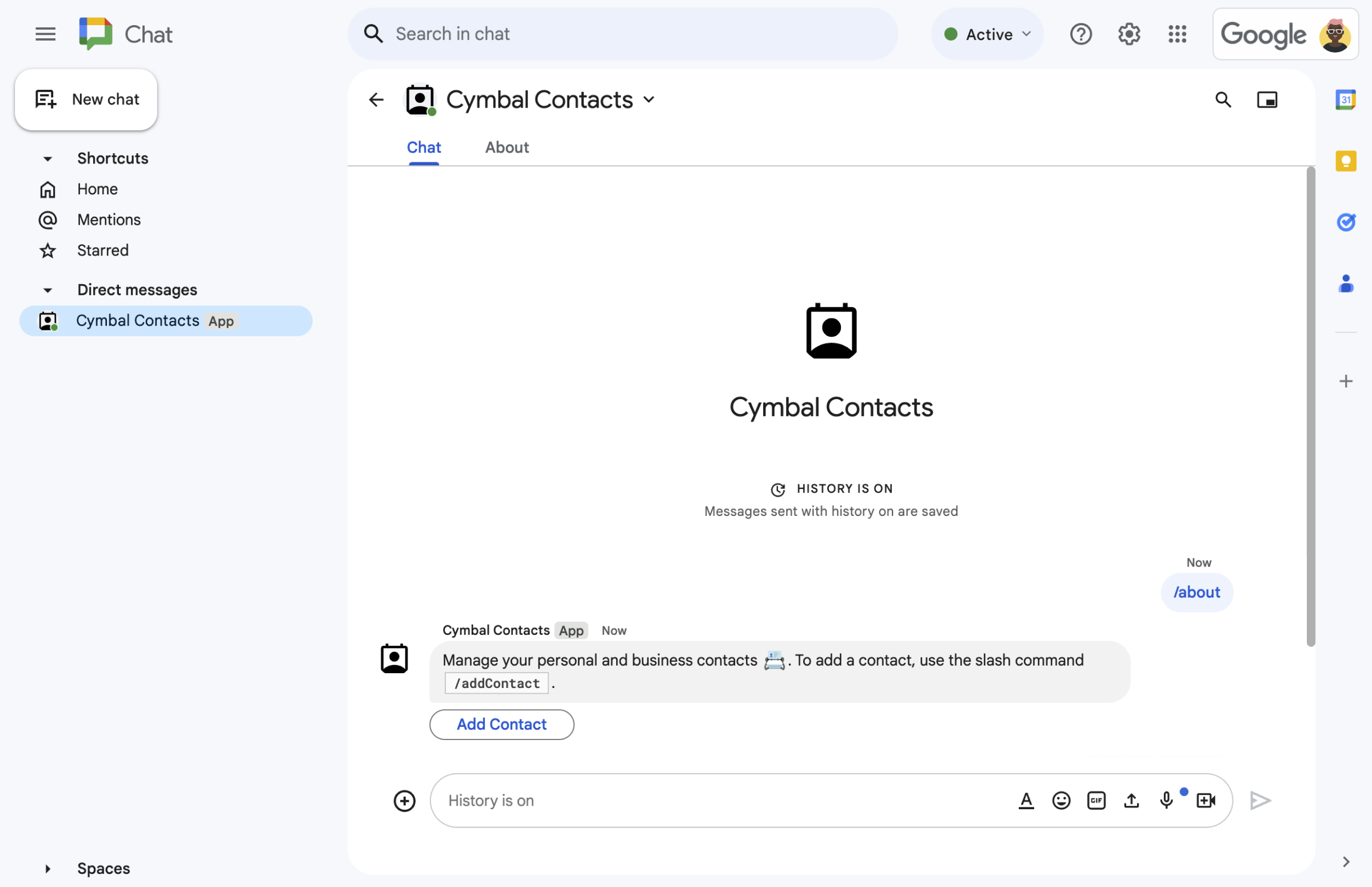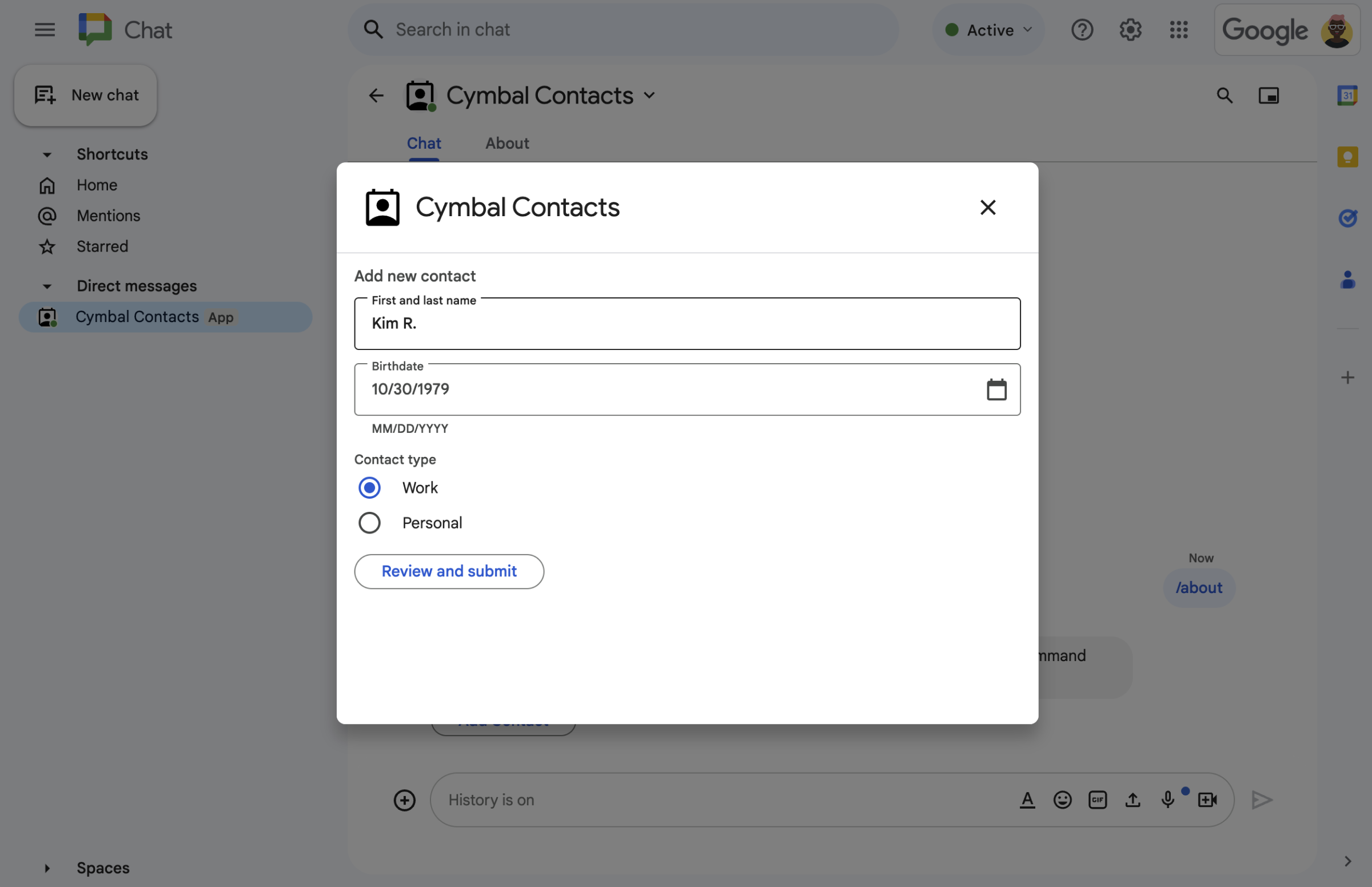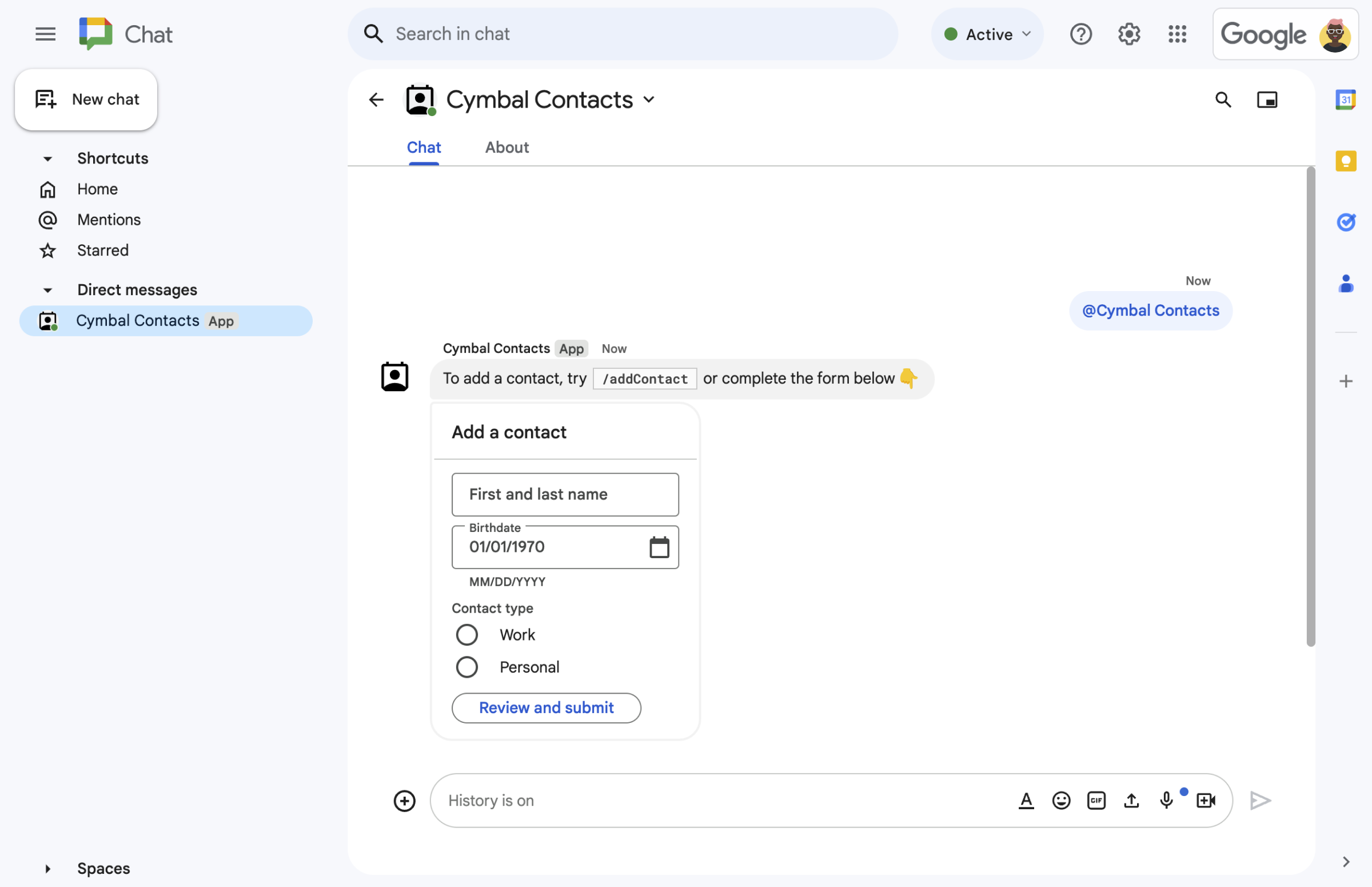本页介绍了 Google Chat 应用如何发送消息来回复用户互动。
-

图 1. 聊天应用通过文本消息和按钮对斜杠命令做出响应。 -

图 2. 聊天应用会打开一个对话框,供用户输入信息。 -

图 5. 聊天应用发送包含文本和交互式卡片的消息。
前提条件
HTTP
扩展 Google Chat 的 Google Workspace 加载项。如需构建一个,请完成 HTTP 快速入门。
Apps 脚本
扩展 Google Chat 的 Google Workspace 加载项。如需构建一个,请完成 Apps 脚本快速入门。
设计消息
聊天应用可以在消息中包含以下任何内容:
- 包含超链接、@提及和表情符号的文本。
- 一个或多个卡片,可以显示在消息中,也可以在新窗口中以对话框的形式打开。
- 一个或多个辅助 widget,即显示在消息中的任何文本或卡片之后的按钮。
如需了解如何设计消息,请参阅以下 Google Chat API 文档:
使用信息回复
聊天应用可以针对以下任何触发器或互动发送消息进行响应:
- 消息触发器,例如当用户 @提及或直接向 Chat 应用发送消息时。
- 添加到聊天室触发器,例如当用户从 Google Workspace Marketplace 安装 Chat 应用或将其添加到聊天室时。
- 消息或对话框中卡片的按钮点击次数。例如,当用户输入信息并点击提交时。
否则,Chat 应用可以通过调用 Google Chat API 来主动发送消息。
如需使用消息进行回复,请返回包含 CreateMessageAction 对象的 DataActions 操作:
{ "hostAppDataAction": { "chatDataAction": { "createMessageAction": {
"message": MESSAGE
}}}
将 MESSAGE 替换为 Chat API 中的 Message 资源。如需详细了解操作的运作方式,请参阅聊天操作。
在以下示例中,每当 Chat 应用被添加到聊天室时,它都会创建并发送一条文本消息。如需在用户将 Chat 应用添加到聊天室时发送短信,您的 Chat 应用应通过返回操作 DataActions 来响应已添加到聊天室触发器:
Node.js
/**
* Sends an onboarding message when the Chat app is added to a space.
*
* @param {Object} req The request object from Google Workspace add-on.
* @param {Object} res The response object from the Chat app.
*/
exports.cymbalApp = function cymbalApp(req, res) {
const chatEvent = req.body.chat;
// Send an onboarding message when added to a Chat space
if (chatEvent.addedToSpacePayload) {
res.json({ hostAppDataAction: { chatDataAction: { createMessageAction: { message: {
text: 'Hi, Cymbal at your service. I help you manage your calendar' +
'from Google Chat. Take a look at your schedule today by typing' +
'`/checkCalendar`, or schedule a meeting with `/scheduleMeeting`. ' +
'To learn what else I can do, type `/help`.'
}}}}});
}
};
Python
from flask import Flask, request, json
app = Flask(__name__)
@app.route('/', methods=['POST'])
def cymbal_app():
"""Sends an onboarding message when the Chat app is added to a space.
Returns:
Mapping[str, Any]: The response object from the Chat app.
"""
chat_event = request.get_json()["chat"]
if "addedToSpacePayload" in chat_event:
return json.jsonify({ "hostAppDataAction": { "chatDataAction": {
"createMessageAction": { "message": {
"text": 'Hi, Cymbal at your service. I help you manage your calendar' +
'from Google Chat. Take a look at your schedule today by typing' +
'`/checkCalendar`, or schedule a meeting with `/scheduleMeeting`. ' +
'To learn what else I can do, type `/help`.'
}}
}}})
Java
@SpringBootApplication
@RestController
public class App {
public static void main(String[] args) {
SpringApplication.run(App.class, args);
}
/*
* Sends an onboarding message when the Chat app is added to a space.
*
* @return The response object from the Chat app.
*/
@PostMapping("/")
@ResponseBody
public GenericJson onEvent(@RequestBody JsonNode event) throws Exception {
JsonNode chatEvent = event.at("/chat");
if(!chatEvent.at("/addedToSpacePayload").isEmpty()) {
return new GenericJson() { {
put("hostAppDataAction", new GenericJson() { {
put("chatDataAction", new GenericJson() { {
put("createMessageAction", new GenericJson() { {
put("message", new Message().setText(
"Hi, Cymbal at your service. I help you manage your calendar" +
"from Google Chat. Take a look at your schedule today by typing" +
"`/checkCalendar`, or schedule a meeting with `/scheduleMeeting`. " +
"To learn what else I can do, type `/help`."
));
} });
} });
} });
} };
}
}
}
Apps 脚本
/**
* Sends an onboarding message when the Chat app is added to a space.
*
* @param {Object} event The event object from Chat API.
* @return {Object} Response from the Chat app.
*/
function onAddedToSpace(event) {
return { hostAppDataAction: { chatDataAction: { createMessageAction: { message: {
text: 'Hi, Cymbal at your service. I help you manage your calendar' +
'from Google Chat. Take a look at your schedule today by typing' +
'`/checkCalendar`, or schedule a meeting with `/scheduleMeeting`. ' +
'To learn what else I can do, type `/help`.'
}}}}};
}
该代码示例会返回以下短信:

如需查看有关如何使用消息进行回复的其他示例,请参阅以下指南:
更新消息
聊天应用还可以更新其发送的消息。例如,在用户提交对话框或点击消息中的按钮后更新消息。
如需更新 Chat 应用消息,请返回包含 UpdateMessageAction 的操作 DataActions,如下例所示:
{ "hostAppDataAction": { "chatDataAction": { "updateMessageAction": {
"message": MESSAGE
}}}}
将 MESSAGE 替换为 Chat API 中的 Message 资源。
如需详细了解操作的运作方式,请参阅聊天操作。
聊天应用还可以更新用户发送的消息,以返回用户发送的链接的预览。如需了解详情,请参阅在 Google Chat 消息中预览链接。
使用 Google Chat API 回复互动或发送主动消息
Chat 应用可能需要使用 Google Chat API 来响应互动,而不是返回加购项操作。例如,Chat 应用必须调用 Google Chat API 才能执行以下任何操作:
- 按计划发送消息,或发送有关外部资源更改的消息。例如,有关新问题或支持请求的通知。
- 在互动后 30 秒以上回复。例如,在完成长时间运行的任务后,使用消息进行响应。
- 在互动发生的聊天室之外发送消息。
- 代表 Chat 用户发送消息。
如需使用 Chat API 发送消息,您必须设置身份验证并对 Message 资源调用 create() 方法。如需了解相关步骤,请参阅使用 Google Chat API 发送消息。
相关主题
- 构建 Google Chat 界面
- 响应快速指令
- 响应斜杠命令
- 打开互动式对话框
- 从 Google Chat 用户那里收集信息
- 预览 Google Chat 消息中的链接
- 使用 Google Chat API 发送消息
